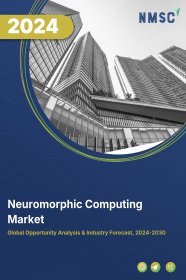
Neuromorphic Computing Market by Component (Hardware, Software, Services, and Full Systems (Integrated)), by Deployment (Edge or On-Device, Cloud or Data-Center, and Hybrid), by Application (Sensory Processing, Signal Processing & Pattern Recognition, Sensor Fusion & Multimodal Integration, Natural Language Processing (NLP), Control & Actuation, Learning & Adaptation, and Others), and by Industry Vertical (Automotive, and Others) – Global Opportunity Analysis and Industry Forecast 2024-2030
Market Definition
The Neuromorphic Computing Market size was valued at USD 4.99 billion in 2023 and is predicted to reach USD 20.86 billion by 2030 with a CAGR of 22.7% from 2024-2030. Neuromorphic computing is a field of computer engineering and neuroscience that involves the design and development of computing systems that are modeled on the human brain. These systems are designed to perform tasks that are difficult or impossible to accomplish with traditional computing architectures. Neuromorphic computing systems use specialized hardware and software to simulate these neural networks and perform tasks such as pattern recognition, image processing, and natural language processing. They are designed to be energy-efficient, scalable, and adaptable to a wide range of applications, including robotics, autonomous vehicles, and smart sensors.
Market Dynamics and Trends
The growing demand for artificial intelligence (AI) expand across industries such as healthcare, finance, automotive, and manufacturing, there is a rising need for advanced computing architectures, including neuromorphic computing to efficiently process large-scale data and execute complex AI algorithms. As per the International Monetary Fund (IMF), it is projected that approximately 60% of jobs in advanced economies will be influenced by AI. In contrast, in emerging markets and low-income countries, the anticipated impact of AI is expected to be 40% and 26%, respectively.
Moreover, the rising demand for the energy efficiency requirements fuels the neuromorphic computing market. As it offers energy-efficient solutions compared to traditional computing architectures, making it appealing for applications where power consumption is a critical concern, such as IoT devices and edge computing.
In addition, the increasing investment from governments, research institutions, and private companies in neuromorphic computing research and development fuels innovation and commercialization efforts, further stimulating demand for neuromorphic computing solutions. For example, ConScience, a microfabrication company, received USD 1.05 million (10 million Swedish Krona) in grants from Vinnova, a Swedish innovation agency. Teaming up with KTH Royal Institute of Technology, they are spearheading the development of artificial neurons for neuromorphic computing, focusing on photonic technology on an LNOI platform to boost energy efficiency and machine learning capabilities.
However, the advancement of neuromorphic computing systems and software demands extensive research, specialized hardware, and software proficiency, leading to substantial development expenses. These high costs can hinder the uptake of such technologies, especially for smaller firms and startups, potentially impeding market expansion. On the contrary, the development of specialized neuromorphic chips optimized for implementing neural network algorithms and architectures that feature parallel processing capabilities and low-power consumption, enabling efficient execution of neuromorphic algorithms is expected to create ample growth opportunities for the market in the future. In 2024, OpenAI announced to buy advanced Neuromorphic AI chips worth of USD 51 million from Rain AI, a startup specializing in developing ultra-low power and high-speed AI Neuromorphic Processing Units (NPUs). Rain AI planned to deliver its first chips by October, aiming to revolutionize neuromorphic computing.
Market Segmentation and Scope of Study
The global neuromorphic computing market is segmented on the basis of component, deployment, application, industry vertical, and region. Based on components, the market is classified into hardware, software, and service. Hardware is further bifurcated into processor and memory. Based on the deployment, the market is segmented into edge computing and cloud computing. On the basis of application, the market is divided into image recognition, signal recognition, and data mining. Based on industry vertical, the market is divided into aerospace, military & defense, automotive, consumer electronics, industrial, medical, IT & telecommunication, and others. Regional breakdown and analysis of each of the aforesaid classifications include regions comprising of North America, Europe, Asia-Pacific, and RoW.
Geographical Analysis
North America dominates the global neuromorphic computing market and is potently expected to remain dominant in the market throughout the forecast period. This is attributed to the growing government support for neuromorphic computing in the region. The government provides funding to develop the infrastructure for neuromorphic computing, which includes specialized research facilities, partnerships between academia and industry, and the establishment of standards and regulations. This creates a supportive ecosystem for the development and adoption of neuromorphic computing technologies. For instance, the US Department of Energy (DoE) invested USD 12.6 million to continue research on next-generation computing. The University of California is the pioneer in the development of quantum materials for energy-efficient neuromorphic computing (Q-MEEN-C). This funding was announced by the DOE after a very competitive procedure.
Furthermore, the presence of several key players such as Intel Corporation and IBM Corporation plays an important role in the growth of the neuromorphic market. For instance, Intel Labs collaborated with the Italian Institute of Technology and the Technical University of Munich to introduce a new neural network approach for object learning. This innovation, leveraging neuromorphic computing, enables robots, including those in logistics, healthcare, and elderly care, to acquire new object knowledge using interactive online learning techniques post-deployment. Also, IBM launched an energy-efficient AI chip built with 7nm technology. The AI hardware accelerator chip supports a wide range of model types while attaining ultra-low power consumption.
On the other hand, Asia-Pacific shows substantial growth in the global neuromorphic computing market due to the growing automotive industry in countries such as China, Japan, and India among others. The use of neuromorphic computing in autonomous driving and advanced driver assistance systems is expected to drive the growth of the neuromorphic computing market in the region. According to the International Organization of Motor Vehicle Manufacturers, China is the largest producer of automotive vehicles, manufacturing more than 21.4 million cars and 4.6 million commercial vehicles in 2021.
Additionally, the surge in the number of IoT devices in countries such as China, Japan, India and South Korea is further fueling the growth of the neuromorphic computing market. The increasing number of IoT devices generates vast amounts of data, which requires efficient and effective processing. Neuromorphic computing technologies provide faster and more efficient processing of this data, making them a key enabler for the growth of IoT applications. According to the International Data Corporation (IDC), the spending on the IoT is forecasted to be reach USD 435 billion in 2027, with a growing CAGR of 11.7% between 2023-2027.
Competitive Landscape
The neuromorphic computing market includes several market players such as Intel Corporation, IBM Corporation, BrainChip Holdings Ltd, Prophesee SA, SynSense AG, GrAI Matter Labs, Innatera Nanosystems B.V., Syntiant Corp., Aspinity, Inc., General Vision Inc., Applied Brain Research, Inc., Rain Neuromorphics, Inc., Knowm Inc., NNAISENSE AG, Numenta, Inc., among others. These market players are adopting various strategies such as product launches and collaboration to maintain their dominance in the global neuromorphic computing market.
For instance, in April 2024, Intel Corporation launched Hala Point, the world’s largest neuromorphic system featuring over 1.15 billion neurons and 128 billion synapses. This new system offers more than 10× the capacity and up to 12× the performance of its predecessor, Pohoiki Springs, with substantial improvements in energy efficiency.
Also, in June 2025, IBM Corporation continued development of its Akida neuromorphic processor series (AKD1000 and AKD1500). These processors use spiking neural networks (SNNs) and are targeted at low-power edge AI devices in sectors like automotive, healthcare, and smart homes.
Moreover, in February 2025, Prophesee SAIntroduced its next-generation Metavision E2v4 event-based vision sensor, offering real-time, low-power detection and motion tracking for robotics and smart city systems..
Key Benefits
-
The neuromorphic computing market report provides the quantitative analysis of the current market and estimations through 2024-2030 that assists in identifying the prevailing market opportunities to capitalize on.
-
The study comprises a deep dive analysis of the neuromorphic computing market trend including the current and future trends for depicting the prevalent investment pockets in the market.
-
The information related to key drivers, restraints and opportunities and their impact on the neuromorphic computing market is provided in the report.
-
The competitive analysis of the market players along with their market share in the neuromorphic computing market
-
The SWOT analysis and Porters Five Forces model is elaborated in the study.
-
Value chain analysis in the market study provides a clear picture of the stakeholders’ roles.
Key Market Segments
By Component
-
Hardware
-
Processors
-
Memory
-
Sensors & Front‑Ends
-
Interconnects & IP Blocks
-
Development Kits & Boards
-
-
Software
-
Development Platforms & SDKs
-
Simulation & Modeling Tools
-
Algorithms & Pre-trained Models
-
Middleware & Frameworks
-
-
Services
-
Consulting & System Integration
-
Custom IP & Design Services
-
Training & Support
-
Maintenance & Optimization Services
-
-
Full Systems (Integrated)
By Deployment
-
Edge or On-Device
-
Cloud or Data-Center
-
Hybrid
By Application
-
Sensory Processing
-
Vision Processing
-
Audio/Speech Processing
-
Other Sensory Processing
-
-
Signal Processing & Pattern Recognition
-
Sensor Fusion & Multimodal Integration
-
Natural Language Processing (NLP)
-
Control & Actuation
-
Learning & Adaptation
-
Optimization & Search
-
Cybersecurity
By Industry Vertical
-
Automotive
-
Aerospace & Defense
-
Healthcare & Medical Devices
-
Consumer Electronics & Smart Home
-
Industrial & Manufacturing
-
IT & Telecommunications
-
Retail & Smart Infrastructure
-
Energy & Utilities
-
Agriculture
-
Other Industries
By Region
-
North America
-
The U.S.
-
Canada
-
Mexico
-
-
Europe
-
The UK
-
Germany
-
France
-
Italy
-
Spain
-
Denmark
-
Netherlands
-
Finland
-
Sweden
-
Norway
-
Russia
-
Rest of Europe
-
-
Asia-Pacific
-
China
-
Japan
-
India
-
South Korea
-
Australia
-
Indonesia
-
Singapore
-
Taiwan
-
Thailand
-
Rest of Asia-Pacific
-
-
RoW
-
Latin America
-
Middle East
-
Africa
-
Key Players
-
Intel Corporation
-
IBM Corporation
-
BrainChip Holdings Ltd
-
Prophesee SA
-
SynSense AG
-
GrAI Matter Labs
-
Innatera Nanosystems B.V.
-
Syntiant Corp.
-
Aspinity, Inc.
-
General Vision Inc.
-
Applied Brain Research, Inc.
-
Rain Neuromorphics, Inc.
-
Knowm Inc.
-
NNAISENSE AG
-
Numenta, Inc.
REPORT SCOPE AND SEGMENTATION:
|
Parameters |
Details |
|
Market Size in 2023 |
USD 4.99 Billion |
|
Revenue Forecast in 2030 |
USD 20.86 Billion |
|
Growth Rate |
CAGR of 22.7% from 2024 to 2030 |
|
Analysis Period |
2023–2030 |
|
Base Year Considered |
2023 |
|
Forecast Period |
2024–2030 |
|
Market Size Estimation |
Billion (USD) |
|
Growth Factors |
|
|
Countries Covered |
28 |
|
Companies Profiled |
15 |
|
Market Share |
Available for 10 companies |
|
Customization Scope |
Free customization (equivalent up to 80 working hours of analysts) after purchase. Addition or alteration to country, regional, and segment scope. |
|
Pricing and Purchase Options |
Avail customized purchase options to meet your exact research needs. |




















 Speak to Our Analyst
Speak to Our Analyst
























